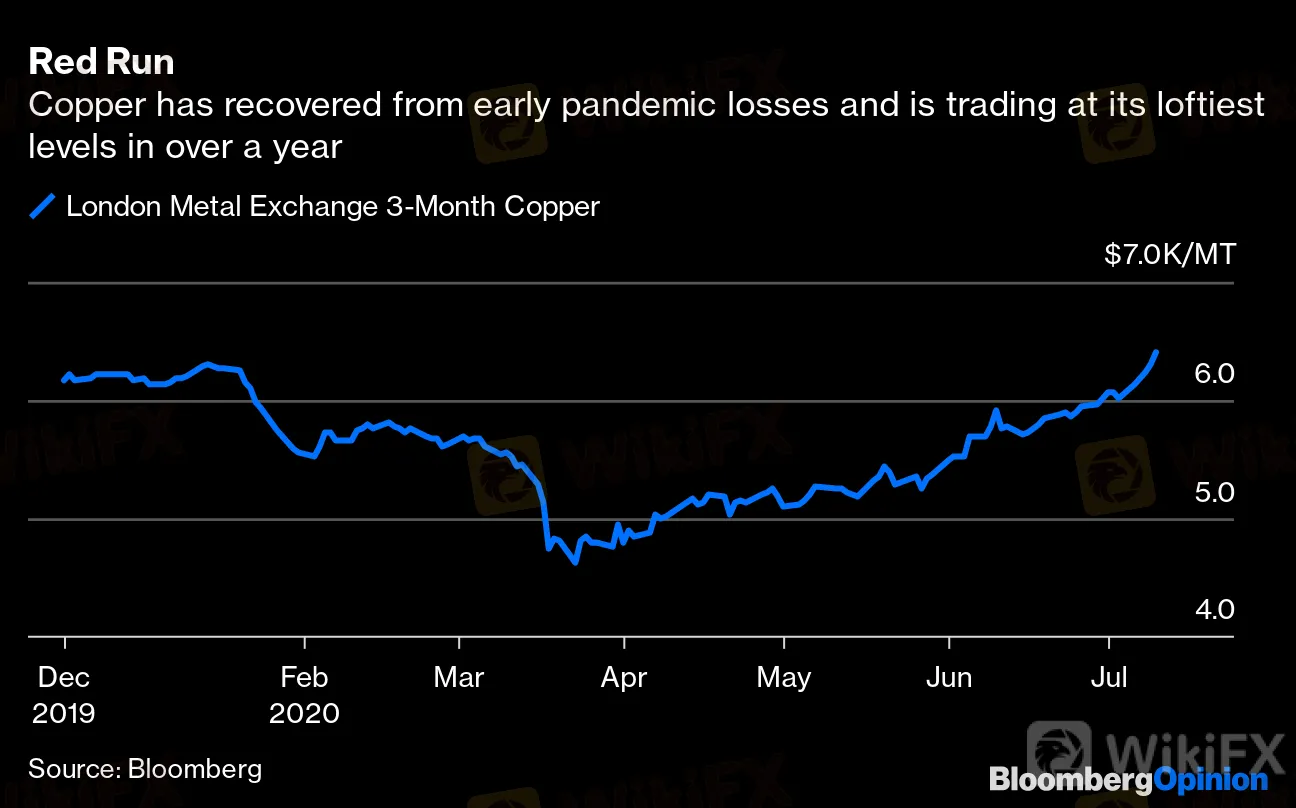简体中文
繁體中文
English
Pусский
日本語
ภาษาไทย
Tiếng Việt
Bahasa Indonesia
Español
हिन्दी
Filippiiniläinen
Français
Deutsch
Português
Türkçe
한국어
العربية
Copper's Made-in-China Rally Has Friends
Abstract:After demand provided the spark, output constraints in coronavirus-hit Latin America may supply the next leg up.
Copper has erased losses racked up in the early months of the coronavirus outbreak. Chinas economic uptick, set to be confirmed by second-quarter figures this week, is encouraging an optimistic view of demand. Latin American supply constraints may be a bigger factor in propelling the price higher, though, with pandemic-related closures and the prospect of strikes ahead. Neither threat will ease soon.
China, which accounts for roughly half of global copper demand, is certainly doing its bit to encourage bulls. Industrial production rose 4.4% from a year earlier in May and is likely to have accelerated further in June. Gross domestic product will expand 3.4% in the second quarter, Bloomberg Economics forecasts, after contracting in the first three months.
Property sales in major cities like Beijing and Shanghai rose above pre-pandemic levels in mid-June. Appetite elsewhere is recovering more slowly — a problem, given almost a third of mainland copper consumption is eventually exported — but China has unquestionably helped the metals recovery from its March lows. Copper has climbed about 40% since then, and is up more than 6% this year to just shy of $6,600 per metric ton on the London Metal Exchange.
The spotlight is now moving. After an initial lift from demand, it is output that is pushing prices higher, as some of the worlds largest producers struggle to contain the Covid-19 epidemic. A forecast 2020 copper surplus is beginning to look like a potential deficit.
The headache? Latin America, which has turned into a coronavirus hotspot, owing to a combination of bad policies and poverty. The region, including Peru and Chile which alone make up 40% of global copper production, now accounts for more than a quarter of daily incremental Covid cases and over two-fifths of the world‘s new deaths. Peru shut down swiftly, but its recovery has been slow. Chile, which has so far allowed mines to keep moving with reduced crews and avoided pit lockdowns, now has one of the world’s highest infection rates.
Take the world‘s largest copper miner, Chile’s state-owned Codelco. It has tightened safety measures, halted smelting activities and slashed staff at its Chuquicamata mine. Its El Teniente expansion is on hold. Still, the company says it has now registered 3,215 infected workers, implying an infection rate far above the general Chilean population.
Red Run
Copper has recovered from early pandemic losses and is trading at its loftiest levels in over a year
Source: Bloomberg

That suggests more restrictions are likely, and that projected output for the top copper-producing nation will be impossible to sustain. Even an official estimate last month that put the Chilean drop this year at 200,000 metric tons — roughly 1% of annual global production — may be optimistic if infection rates don‘t improve. Unions, meanwhile, may begin to agitate more loudly over safety and other worries. The pandemic isn't putting off existing disputes. Workers at Antofagasta Plc’s Zaldivar mine have rejected a final wage offer and voted to walk out. At BHP Group‘s Escondida, an early retirement offer has gone down badly. Post-coronavirus efforts to increase efficiency there are elsewhere won’t do much better.
And thats just Chile.
Mexico‘s outbreak has been devastating, with deaths now higher than Italy’s. First Quantum Minerals Ltd.‘s Cobre Panama is only just beginning a reopening plan. Africa’s copper producers are hurting too, particularly Zambia.
The copper market is used to supply disruptions: Strikes and outages are annual occurrences. Yet problems are beginning to pile up, against the backdrop of a stronger-than-expected Chinese recovery and limited stockpiles that have magnified the price impact of any hiccups. Global visible inventories have declined 30% since March, according to Jefferies. Thats good news for miners like Freeport McMoRan Inc., which has said the expansion of its Grasberg mine in Indonesia is on track. That may well change with a smaller team onsite, but Freeport shares have more than doubled since March. Speculators adding to bullish copper bets will help.
The bigger question is what this means for supply beyond the next few months. Production was constrained even before the coronavirus. Now, projects have been pushed back, while exploration and development budgets have been trimmed across the sector. Financially squeezed, Codelco in particular could see expansions shelved. And copper is still trading below prices that would get miners racing to dig again — that in theory requires at least $7,000 per metric ton, a level last hit more than two years ago.
Supply pressures are here to stay.
Disclaimer:
The views in this article only represent the author's personal views, and do not constitute investment advice on this platform. This platform does not guarantee the accuracy, completeness and timeliness of the information in the article, and will not be liable for any loss caused by the use of or reliance on the information in the article.
WikiFX Broker
Latest News
Brazilian Man Charged in $290 Million Crypto Ponzi Scheme Affecting 126,000 Investors
Become a Full-Time FX Trader in 6 Simple Steps
ATFX Enhances Trading Platform with BlackArrow Integration
IG 2025 Most Comprehensive Review
SEC Drops Coinbase Lawsuit, Signals Crypto Policy Shift
Construction Datuk Director Loses RM26.6 Mil to UVKXE Crypto Scam
Should You Choose Rock-West or Avoid it?
Franklin Templeton Submitted S-1 Filing for Spot Solana ETF to the SEC on February 21
Scam Couple behind NECCORPO Arrested by Thai Authorities
Top Profitable Forex Trading Strategies for New Traders
Currency Calculator






